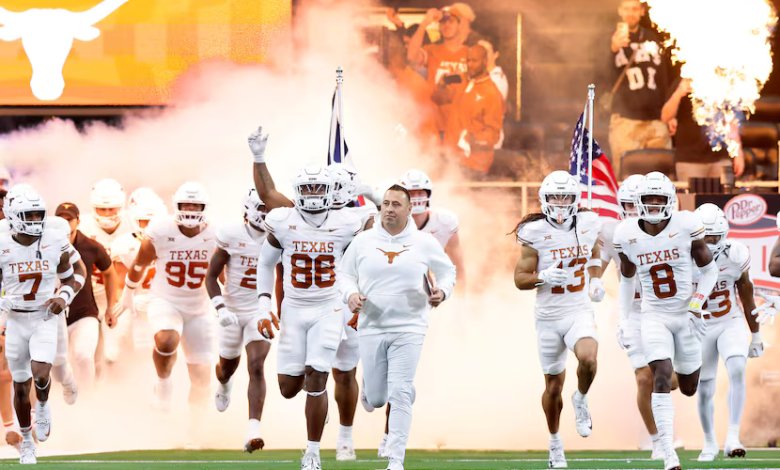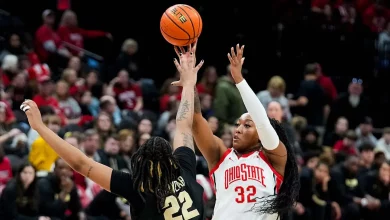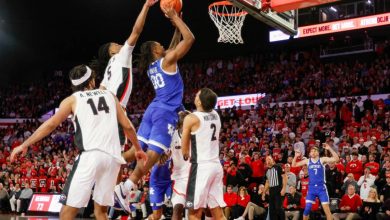Although the Longhorns and Aggies share the same SEC address, their athletic programs generate distinct amounts of money and expenses.

Although the Longhorns and Aggies Share the Same SEC Address, Their Athletic Programs Generate Distinct Amounts of Money and Expenses
The Texas Longhorns and the Texas A&M Aggies have long been two of the most prominent and successful athletic programs in college sports. These two schools, both located in Texas, have achieved a great deal of success in various sports and have storied football programs. With the recent shift in college athletics, especially with Texas and Oklahoma joining the Southeastern Conference (SEC), the rivalry between the Longhorns and Aggies is entering a new chapter. The two programs will now compete within the same conference, but despite sharing the same SEC address, their athletic programs operate very differently in terms of revenue generation and expenses.
While both programs are historically successful and boast large, dedicated fan bases, the financial aspects of their respective athletic programs reveal distinct disparities. These differences are rooted in various factors, including historical revenue streams, infrastructure, sponsorship deals, and athletic expenditures. This article will explore how the financial landscape of both the Texas Longhorns and the Texas A&M Aggies compares and contrasts, examining how their respective budgets, income, and spending affect their long-term athletic success.
Revenue Generation: The Texas Longhorns
The Texas Longhorns are one of the wealthiest athletic programs in the United States. The financial success of Texas athletics is driven by a combination of factors that includes a massive fan base, a lucrative television deal, extensive corporate sponsorships, and a commitment to facilities and infrastructure.
Television and Media Deals
One of the primary drivers of Texas’ athletic revenue is the media rights deals the university has secured. The Longhorns signed an incredibly lucrative deal with the Longhorn Network (LHN), a television network dedicated solely to Texas sports. While the network has faced some challenges in terms of viewership and distribution, the revenue it generates remains substantial. The Longhorns also benefit from the television contracts of the Big 12 Conference (until their upcoming transition to the SEC), and once Texas officially joins the SEC, they will reap the rewards of one of the most lucrative television contracts in all of college athletics.
The SEC’s media rights deal, which includes a significant partnership with ESPN, is worth billions of dollars and will significantly boost Texas’ financial standing within the conference. By moving to the SEC, the Longhorns are expected to see a major uptick in revenue from television rights, which will be shared among conference members. This added influx of money will elevate Texas’ ability to continue investing in its athletic programs, providing even greater financial resources for recruiting, facility upgrades, and other expenses.
Football and Basketball Revenue
Texas football is one of the richest programs in college athletics, and the revenue it generates is a massive contributor to the overall financial health of the university’s athletic department. Darrell K Royal–Texas Memorial Stadium consistently fills to capacity, generating millions of dollars in ticket sales and in-game revenue, including concessions, premium seating, and suite rentals. Texas is also one of the leaders in merchandise sales, with the Longhorns logo and branding being among the most recognized in college sports.
The basketball program at Texas, while not as financially dominant as football, still generates significant revenue through ticket sales, merchandise, and television contracts. Mike White, the head basketball coach, has brought renewed energy to the program, leading to an uptick in attendance and fan engagement, further contributing to the department’s financial success.
Corporate Sponsorships
Texas has long been one of the most attractive schools for corporate sponsors. The program has secured high-profile partnerships with major brands such as Nike, AT&T, and Dr Pepper, which offer significant revenue opportunities through exclusive deals, sponsorships, and branded content. Corporate sponsors are drawn to the Longhorns not only because of their on-field success but also due to the massive exposure the program receives, especially within the football community. These sponsorships help fill the financial gap between revenue generated from ticket sales and the operational costs of running such a large athletic program.
The Longhorns’ ability to leverage their success in recruiting, brand recognition, and media presence to secure these lucrative sponsorships has been a crucial component in maintaining their status as one of the wealthiest athletic programs in the nation.
Facilities and Infrastructure
The Texas Longhorns have invested heavily in building world-class athletic facilities. The Frank Erwin Center, Bevo Blvd., and the South End Zone at DKR Memorial Stadium are examples of how the Longhorns’ financial resources have been poured into state-of-the-art infrastructure to enhance both the student-athlete experience and the fan experience. These investments not only help improve performance on the field but also serve to increase revenue by attracting more fans, recruits, and corporate partners. Having top-tier facilities is an essential factor in maintaining a program’s financial success and long-term sustainability.
Revenue Generation: The Texas A&M Aggies
Texas A&M, although it shares the same state as Texas, operates within a different financial framework, which is influenced by various historical and strategic factors. While Texas A&M’s athletic department is also financially successful, it differs from Texas in several ways, including the types of revenue it generates and its reliance on the surrounding community.
The SEC’s Media Rights Deal
Since Texas A&M joined the SEC in 2012, it has been benefiting from the conference’s highly lucrative media rights deal. The SEC’s television contract, which involves deals with both ESPN and CBS, has allowed Texas A&M to generate significant revenue. The Aggies are able to capitalize on the media exposure from the SEC’s network of televised games, which brings in millions of dollars annually. However, Texas A&M is not quite in the same position as Texas, as they have not benefited from a deal like the Longhorn Network, which allowed Texas to negotiate a more independent deal for media rights.
As Texas A&M transitions into an era where Texas joins the SEC, there will likely be increased competition for the media revenue pie, but it is important to note that the Aggies will still benefit from the overall growth and expansion of the SEC’s brand. However, the disparity in media rights revenues between the two schools will remain a defining factor for each program’s financial future.
Football and Basketball Revenue
Like Texas, Texas A&M has a highly successful football program that generates substantial revenue. Kyle Field regularly sells out, bringing in millions of dollars through ticket sales, premium seating, and concessions. The Aggies’ football program also benefits from lucrative sponsorships and partnerships, with companies like Nike and AT&T aligning themselves with the university’s brand.
In terms of basketball, Texas A&M has seen moderate success under coach Buzz Williams, although the program hasn’t reached the same level of financial success or national prominence as Texas basketball. Still, the Aggies have enjoyed solid ticket sales, media revenue, and sponsorships related to their basketball program.
Corporate Sponsorships
Texas A&M also benefits from significant corporate sponsorships, including partnerships with companies like Nike, Coca-Cola, and Reese’s. These sponsorships help increase the university’s athletic revenue stream, but the Aggies’ ability to attract top-tier corporate sponsors may not be quite as robust as that of Texas, largely due to the difference in national exposure. Texas’ history of sustained football success and media attention has allowed them to secure even more sponsorships and lucrative deals.
Facilities and Infrastructure
Texas A&M has invested heavily in its athletic facilities, and Kyle Field underwent a massive renovation to enhance the fan experience and create premium seating options. These upgrades help generate additional revenue through high-end seating, suites, and increased ticket prices. Additionally, the Aggie Athletics Village provides cutting-edge amenities for student-athletes, which is essential for recruiting top-tier talent and maintaining a competitive program.
While Texas A&M’s facilities are excellent, they still trail Texas in terms of sheer scale and investment. The Longhorns have been able to pour more resources into their infrastructure, giving them an edge in recruiting and fan engagement. That said, Texas A&M’s financial position is still strong, and they are well-equipped to compete with other SEC programs for top recruits and talent.
Comparing Expenses: Texas vs. Texas A&M
While both programs generate significant revenue, their expenses also differ. Both Texas and Texas A&M invest heavily in their athletic programs, but Texas, given its higher revenue streams, can afford to spend more on coaches, facilities, and player development.
Texas A&M has made significant investments in its football program, including coaching salaries, player support, and recruiting budgets. However, they do not have the same resources as Texas to compete on a national level in terms of financial expenditures. Texas’ larger fan base and media contracts allow them to spend more freely in areas like recruiting, facilities, and coaching salaries.









